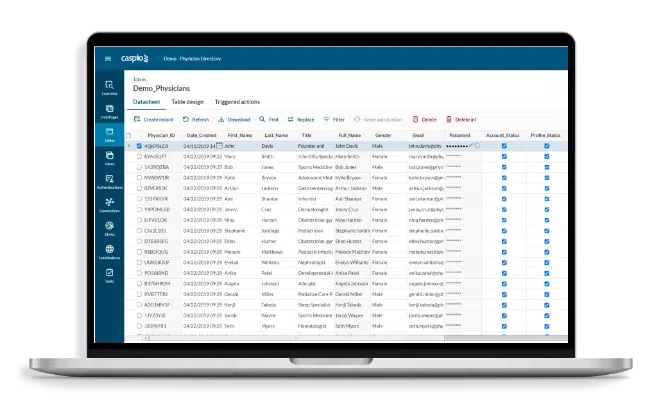No-Code Open System Data Source Production: Empowering Companies to Develop Faster
No-Code Open System Data Source Production: Empowering Companies to Develop Faster
Blog Article
Discover How Scalable Databases Can Be Used Without Coding to Boost Your Service Operations
In today's busy organization setting, the capacity to take care of and analyze data successfully is vital. no-code. Scalable data sources, especially when combined with no-code options, offer a transformative technique that equips non-technical users to streamline operations.
Understanding Scalable Data Sources
Scalable databases are necessary for contemporary company procedures, permitting organizations to effectively handle increasing quantities of information without sacrificing performance. These data sources are created to adjust and grow to the transforming demands of an organization, guaranteeing that they can handle larger datasets and more intricate questions as business requirements advance.
Comprehending scalable data sources includes acknowledging their two key kinds: vertical scaling and straight scaling. Vertical scaling, or "scaling up," entails including more power (CPU, RAM) to an existing web server to boost efficiency. On the other hand, straight scaling, or "scaling out," involves including a lot more web servers to distribute the tons, which typically leads to greater adaptability and mistake resistance.
One more important facet is the architecture of scalable databases, which can be either non-relational or relational. Relational data sources, such as MySQL and PostgreSQL, are structured and make use of SQL for inquiries, while non-relational databases, like MongoDB and Cassandra, supply more versatility with unstructured information.
Ultimately, recognizing scalable databases is essential for organizations aiming to leverage information as a tactical asset, allowing them to remain affordable in an increasingly data-driven atmosphere.

Advantages of No-Code Solutions
Opening the potential of no-code remedies encourages services to improve operations and improve performance without the requirement for comprehensive programming expertise. These systems allow non-technical customers to create, change, and handle databases effortlessly, hence equalizing accessibility to modern technology throughout teams.
One of the primary benefits of no-code services is their rate of application. Companies can promptly deploy applications and automate processes, significantly lowering the time spent on advancement cycles. This dexterity makes it possible for companies to respond immediately to market modifications and customer requirements, cultivating an affordable side.
In addition, no-code systems reduce dependence on IT divisions for day-to-day tasks, enabling technological groups to focus on more complex tasks that call for specialized skills. This shift not only maximizes source allowance yet additionally promotes innovation within the organization.
Cost-effectiveness is an additional benefit, as no-code remedies can lower development and maintenance costs. By reducing the requirement for coding competence, firms can harness the capacities of their existing workforce without the expenses of working with additional employees.
Popular No-Code Database Devices
The surge of no-code remedies has actually caused the emergence of numerous data source devices that accommodate organizations seeking effectiveness and access. These devices empower individuals with limited technological competence to create, manage, and control data sources perfectly.

Caspio sticks out for its ability to build internet applications without any kind of coding. It enables services to produce robust databases and release applications promptly, accommodating different industry demands. Similarly, Flair provides user-friendly user interfaces and effective data management capacities, making it possible for organizations to build personalized applications customized to their process.

Use Situations in Company Workflow
Just how can services take advantage of database tools to boost their procedures? Scalable data sources supply companies with check over here effective capacities to manage and examine data without the need for comprehensive coding understanding. These tools can streamline numerous service processes, ultimately causing boosted effectiveness and productivity.
One prominent usage situation is customer partnership management (CRM) Companies can make use of scalable data sources to track consumer interactions, choices, and comments, allowing customized interaction and much better service. By systematizing this details, teams can team up a lot more efficiently and react to client needs in real-time.
Another substantial application is stock management. Business can employ no-code data source devices to check stock degrees, track shipments, and projection demand. This makes certain ideal supply levels, lowers waste, and reduces stockouts.
Furthermore, task management can profit from scalable data sources by enabling groups to handle tasks, target dates, and resources in a merged platform. With real-time updates and data visualization, job supervisors can make educated choices.
Getting Going With Execution
Executing scalable data sources in business operations calls for a structured method to make sure effective integration and usage. The primary step is to carry out an extensive demands evaluation, determining details business demands, information kinds, and anticipated growth patterns. This foundational understanding will direct the choice of the ideal data source solution.
Next, select an easy to use, no-code data source platform that lines up with your functional objectives. no-code. Several modern-day solutions offer instinctive interfaces, allowing non-technical users to manage see this website data efficiently. After choosing a platform, develop a clear data design that lays out how information will certainly be arranged, accessed, and preserved
Training is essential; make sure that staff member are geared up with the required skills to utilize the database. Consider providing workshops or tutorials to acquaint personnel with the system's performances.
Final Thought
In verdict, the integration of scalable data sources with no-code my link services presents significant benefits for service operations. These platforms encourage non-technical individuals to successfully handle and examine data, helping with improved decision-making and cooperation. By embracing tools such as Airtable and Idea, companies can lower and enhance processes dependence on IT sources. Eventually, leveraging these innovations can result in boosted efficiency and operational performance, positioning organizations for sustained development in an affordable landscape.
One popular no-code database device is Airtable, which incorporates the capability of a spread sheet with the power of a database.Just how can companies utilize database tools to boost their procedures? Companies can make use of scalable databases to track client communications, preferences, and comments, enabling tailored interaction and far better solution.Implementing scalable databases in service procedures requires a structured technique to make certain successful combination and application.In conclusion, the combination of scalable data sources with no-code remedies provides substantial benefits for business operations.
Report this page